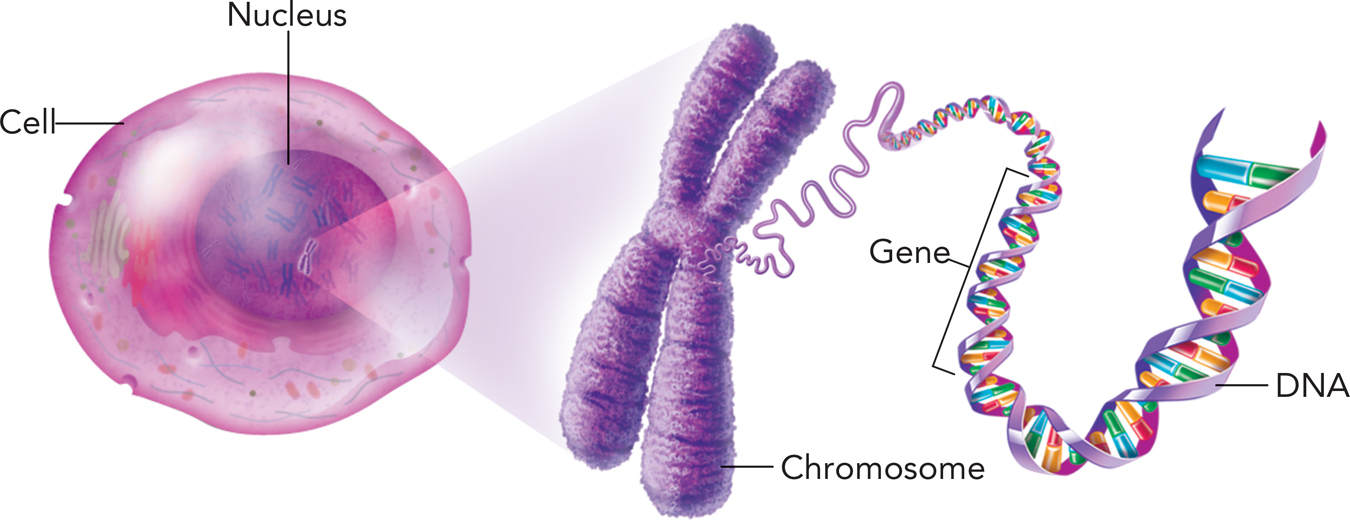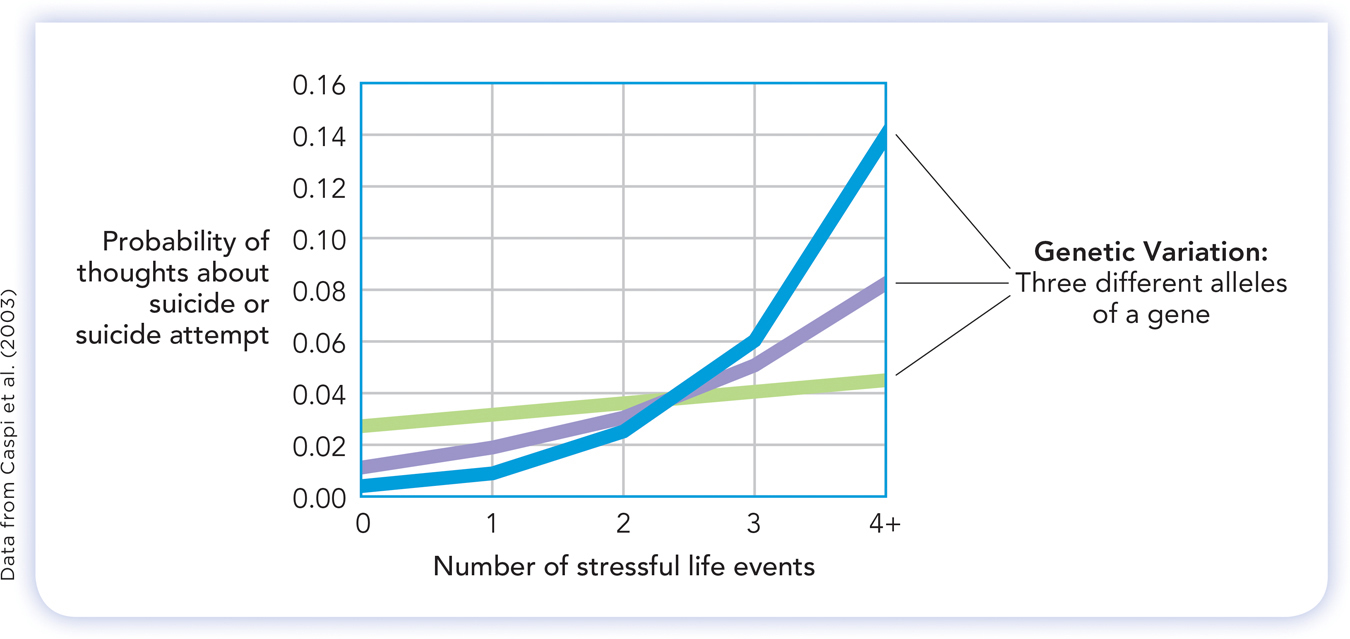4.3 Genes and Individual Development
Thus far, we primarily have examined research on psychological characteristics: personality, psychological disorders, social attitudes, intelligence. Results reveal three facts about nature, nurture, and the psychology of people:
Genetic similarity contributes to psychological similarity. Identical twins, with their identical genes, are particularly similar to one another psychologically.
Environments are influential. People who are genetically identical often differ psychologically.
Genes and environments interact. You learned at the beginning of this chapter, for example, that the effect of genes on intelligence differed among people living in wealthy or poor environments.
If you’re thinking like a scientist, the question you’re asking is “why?” If we shift from a psychological to a biological level of analysis, can we explain why people’s psychological qualities are affected by nature, nurture, and nature–
Yes, we can, thanks to research on genes and gene expression.
Chromosomes, Genes, and Gene Expression
Preview Questions
Question
 What is the relation between chromosomes, DNA, genes, and the genome?
What is the relation between chromosomes, DNA, genes, and the genome?
Question
 How do we get from DNA to protein building?
How do we get from DNA to protein building?
Your body’s cells are, in some ways, like books. Books contain a chemical substance: ink. The ink, thanks to its arrangement on the page, conveys information—
DNA AND GENES. The main ingredient needed to build body parts is protein molecules. Your body assembles protein molecules by following instructions encoded into DNA. This information is contained in the long sequence of chemical elements that make up the DNA molecule.
Any section of DNA that provides the full information needed to produce a protein is called a gene. Genes thus are the basic units of inheritance: the instructions used to build the body’s parts. The entire set of genes—
In the cells of the body, genes are contained within chromosomes, biological structures that consist of highly organized, tightly packed strings of molecules (Figure 4.7). The cells of your body contain 46 chromosomes, which are located in the nucleus of the cells. Chromosomes are so small that 46 of them easily fit within a cell’s nucleus. Yet they are so tightly packed that if you unwound any one chromosome and stretched it end to end, it would be roughly 6 feet long (National Institutes of General Medical Sciences, 2006).

We truly are a single human family; the genome is extremely similar from one person to the next. More than 99% of the sequences of biological molecules in DNA are the same in all persons, in all cultures of the world (National Institutes of General Medical Sciences, 2006). Yet there are variations. A given gene can come in different varieties, known as alleles. Different alleles produce different versions of a characteristic. For example, a gene that produces a chemical affecting bodily coloration comes in different alleles that are responsible for blue versus brown eye color (Sturm et al., 2008). Allelic variations in other genes are responsible for different human blood types.
GENE EXPRESSION. There is a second way in which your body’s cells are like books. The information in a book has no effect unless the book is opened, read, and acted upon. A cookbook with a cake recipe will not, by itself, produce any cakes; for that, ingredients must be assembled according to the recipe’s instructions. Similarly, when the body wants to build a protein, the “recipe”—the information in DNA—
This assembly process—
A molecule in the nucleus of a cell reads the information in DNA and creates another molecule, ribonucleic acid (RNA), which contains a copy of the DNA protein-
building recipe. RNA is transported from one location in the cell to another, where there is biochemical machinery needed to build proteins (Nakielny et al., 1997).
Cellular machinery reads the information in RNA, gathers molecules needed to build a protein, and assembles them according to the instructions that originally came from the DNA.
WHAT DO YOU KNOW?…
Question 7
Your body’s cells are to books what the arrangement of the ink on their pages is to . Within the nucleus of your body’s cells are 46 chromosomes that contain , which are sections of DNA that contain information needed to produce a protein. Variations in genes are called . The process by which the “instructions” contained in DNA produce protein molecules is referred to as expression.
Environmental Experience: Nurture Affects Nature
Preview Question
Question
 How do our experiences affect gene expression? In other words, how does nurture influence nature?
How do our experiences affect gene expression? In other words, how does nurture influence nature?
What does the biology of gene expression have to do with the psychology of nature and nurture? Quite a lot! The timing of gene expression—
EPIGENETICS. In the field of epigenetics, researchers study how environmental experience “switches on” genes, making them active in the production of proteins (Masterpasqua, 2009). The switching-
Some environmental experiences alter the internal state of the body. For example, if you are under a lot of stress, your body may feel different to you; this feeling reflects internal body-
state changes brought on by the stress (see Chapter 10). The body-
state changes affect biochemical activity occurring within the nucleus of cells. This biochemical activity can alter gene expression— the “switching on” of genes— because the cell nucleus is where chromosomes and, thus, genes reside.
As a result of this two-
Epigenetic principles have a fascinating implication: People with identical DNA may differ biologically if they experience environments that prompt different types of gene expression. You can see this in the accompanying photo. The two men differ physically; one is markedly taller and heavier. The difference might lead you to guess they are unrelated. But, in reality, they’re identical twins. After being separated at birth, the man on the right was raised in a normal caring environment, whereas the man on the left was raised by “a neurotic and cruel relative” (Tanner, 1978, p. 121) who failed to provide adequate nutrition. The result was biological differences despite identical genes.
This example should remind you of HT1, HT2, and HM, the triplets described in this chapter’s opening story. HM differed in behavioral style and sexual orientation from his brothers. Epigenetic processes could have caused the differences. Although HM had the same DNA as his brothers, environmental experiences could have “switched on” his genes in a way that differed from gene activation in HT1 and HT2.
The lesson? DNA is not destiny. Genes alone do not determine biological outcomes. Instead, in the development of the organism, genetic and environmental influences combine through epigenetic processes. Let’s see some examples of epigenetics in action.
Epigenetic research has identified numerous factors that influence gene expression. For instance, stress, poor nutrition, loneliness, and parenting styles can affect whether, and when, cells use the information in DNA to produce proteins (Cole, 2009; Gottlieb, 1998; McEwen et al., 2012). One major focus of such research has been social relationships and physical health.

Researchers have long known that social factors influence physical health (Uchino, Cacioppo, & Kiecolt-
Research on parenting (Champagne & Curley, 2009) provides another example of how experiences can affect gene expression and biological structure. The parents studied in this work were not human but rodent; laboratory rats, like people, have offspring that require care, and basic principles discovered in one species may generalize to another. When starting their work, the researchers knew that not all rat mothers are alike. Some attend closely to their infant pups, frequently licking and grooming them, whereas others spend much less time physically interacting with their offspring. The researchers also knew that the mothers’ actions could predict the rat pups’ later behavior; offspring of mothers who do a lot of licking and grooming tend to develop into adult rats that are relatively less fearful than others. Through what process, the researchers asked, could licking and grooming in infancy affect emotions and behaviors in adulthood? The answer turned out to be gene expression (Weaver, Meaney, & Szyf, 2006). Frequent grooming and licking during the first week of life altered chemical processes in cells. These alterations affected gene expression. The altered levels of gene expression, in turn, affected the biological and behavioral development of the baby rats.
THINK ABOUT IT
Research on social isolation, gene expression, and human health is correlational; social isolation is correlated with gene expression and health outcomes. But correlation does not prove causation. These findings thus do not provide evidence of a causal impact of social isolation on genetic mechanisms and health. However, other research, conducted with nonhuman animals, does provide such evidence. Experimentally manipulated levels of social isolation produce variations in animals’ gene expression and immune system functioning (Slavich & Cole, 2013).

RESEARCH TOOLKIT
Molecular Genetic Methods
A generation ago, psychology’s main tool for studying nature and nurture was the twin method. It succeeded in answering—
With that question answered, new ones arise: Which genes influence which psychological characteristics? How do they do it? How do environmental factors affect the process? These new questions require a new tool: molecular genetic methods.
Molecular genetic methods are biological techniques for studying specific genes and variations in those genes. Researchers analyze the molecular material in DNA (something not done in traditional twin studies). By identifying different alleles of a gene, they can relate those specific genetic variations to specific types of behavior.
Molecular genetic methods require biological material, such as a small blood sample from participants or cells collected from inside the mouth using a cotton swab. Researchers then analyze this material biologically, separating the DNA from other biochemical matter in the cells and then scrutinizing the genetic material (Association of Genetic Technologists, 2008).
Sometimes researchers know exactly what they’re looking for in the DNA. They may wish, for example, to determine which of two different alleles of a specific gene is possessed by an individual. If so, they will scrutinize the genome at the specific location at which the gene of interest can be found.
However, sometimes there is no specific search plan. Researchers know that, somewhere in the genome, there must be genes associated with a psychological variable of interest, but they don’t know where these genes are located along the lengthy strand DNA. They thus conduct a genome-

Molecular genetic methods capitalize on knowledge gained through the Human Genome Project, an international effort to map the entire sequence of molecular material in the human genetic code. The project, begun in 1990, was completed in 2003 (National Human Genome Research Institute, 2003). Ever since, when researchers explore the genome, they do so with the benefit of a detailed map.
WHAT DO YOU KNOW?…
Question 8
In molecular genetic methods, researchers analyze the molecular material found in DNA to identify that may be at least partly responsible for certain behaviors.
GENE–
The researchers measured two factors that might predict the development of depression, one genetic and the other environmental. The genetic factor was variation in—
Key to this study was that, as in other studies reviewed earlier in this chapter, the researchers did not ask the simple question, “Nature versus nurture: Which is more important?” Instead, they explored how genes and environments work together in helping people avoid depression or, alternatively, in contributing to the development of depressive symptoms.

Figure 4.8 shows how genetic and environmental effects combined to predict the development of one symptom of severe depression, suicidal behaviors and thoughts (Caspi et al., 2003). Were genes influential? Sometimes yes, and sometimes no. Among people who experienced few stressful life events, genetic variations hardly made any difference. In low-
The findings, which have been replicated by others (Karg et al., 2011), show how nature and nurture combine in the development of depression. People who experience high levels of environmental stress and who, due to genes that affect serotonin levels, are biologically inclined to react strongly to stressors are at greatest risk.
In summary, contemporary research shows not only that genes are important, but also that their importance, and basic workings, are best understood by looking at how genetic and environmental factors combine in the psychological development of the individual.
WHAT DO YOU KNOW?…
Question 9
Describe the concept of epigenetics. How would an epigenetics researcher respond to the question, “Which is more important, nature or nurture?”
THIS JUST IN
“Identical” Twins
Monozygotic (MZ) twins originate from the splitting of one zygote. We call the twins “identical” and, for years, textbooks have taught that their genes are exactly the same, all along the genome. But this just in …
“Identical” twins are not always genetically identical after all. They are extremely similar; their genomes overlap enormously. Yet they aren’t necessarily identical, and the differences can be significant.
Initial evidence of genetic variation in MZ twins came from a study of 19 MZ twin pairs (Bruder et al., 2008). When analyzing their genomes, researchers noticed differences; twins sometimes differed in the number of copies of a given gene that they possessed. Thanks to fluctuating biochemical processes occurring inside cells, sometimes one twin would be missing a gene, or have two or more copies of a gene, instead of having one copy of the gene like his or her co-
Another study examined the genetic makeup of identical twins who varied in schizophrenia, that is, one had the mental disorder and the other did not. Again, the identical twins differed genetically, which might explain the difference in their schizophrenic symptoms (Maiti et al., 2011).
These new findings have big implications for the study of nature and nurture. In the past, when identical twins have differed in their behavior, emotion, or patterns of thinking, researchers have attributed the differences to nurture. Because the twins were identical biologically, scientists reasoned, differences between them must be due to environmental experience. But now, scientists know that, in at least some cases, behavioral differences between identical twins can be caused by differences in genetics.
Does this remind you of HM, HT1, and HT2, from our opening story? HM differed from his “genetically identical” brothers. It’s possible that he was not, in fact, genetically identical!
WHAT DO YOU KNOW?…
Question 10
When MZ twins do differ genetically, it is because one twin may differ from the other in the number of copies of a he or she possesses.
TRY THIS!
It is now time to switch from reading about psychology research to experiencing it. Go to www.pmbpsychology.com to find the Try This! activity for Chapter 4, where you will be asked to solve some problems. As you try them, ask yourself what these problems might have to do with the topic of this chapter, nature and nurture. We will discuss the activity later on in this chapter. ![]()